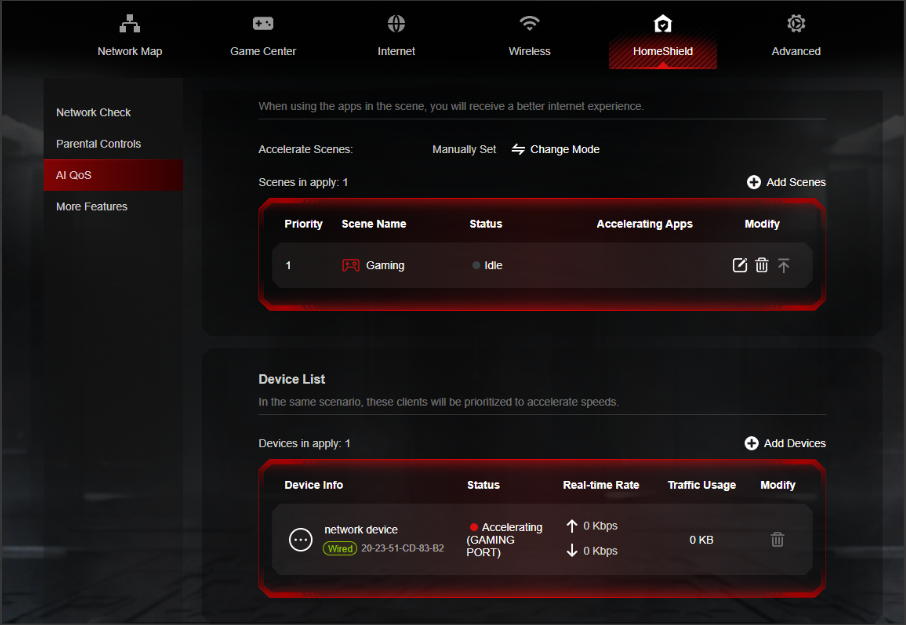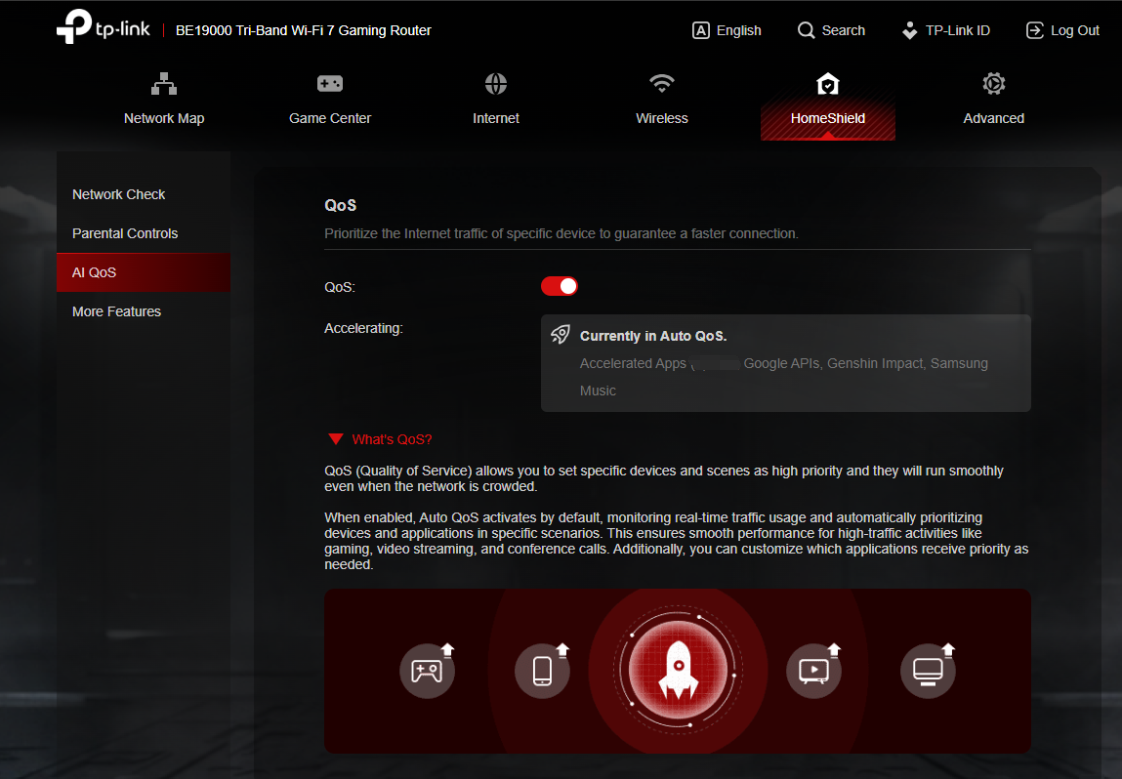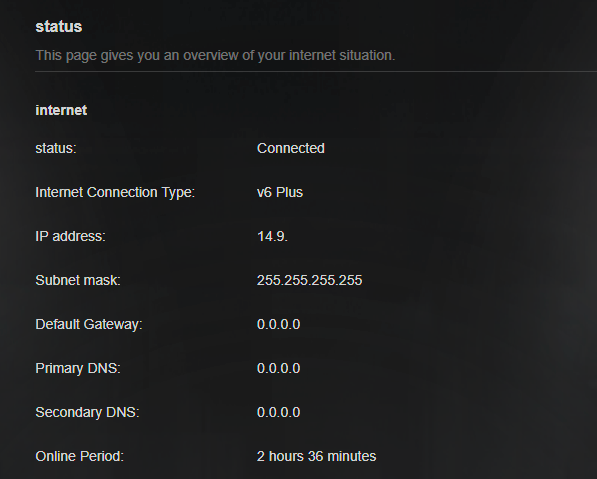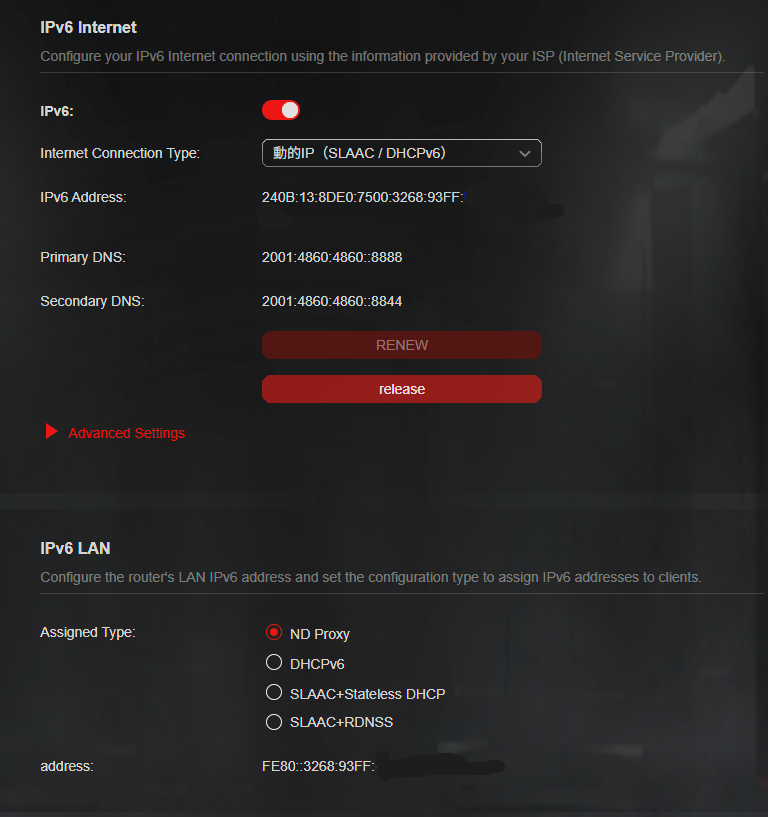Early Access Introducing AI QoS: Elevate Your Gaming Experience on the Archer GE800 Gaming Router!
Hello Everyone,
We are excited to announce a pre-release firmware update introducing AI QoS (Quality of Service) for the Archer GE800 V1 before its official release. This allows our users to enjoy the ultimate gaming experience in advance.
AI QoS is designed to revolutionize your online gaming experience. Leveraging artificial intelligence, our new feature set transforms how your router manages bandwidth, ensuring seamless performance for all your applications. Here are the key features that make AI QoS a game-changer.
One-Click Acceleration
Say goodbye to complicated setups! With just a single click, you can enjoy lightning-fast performance without the hassle of complex configurations. Get ready to dive into your favorite games instantly.

Dynamic Bandwidth Detection
Our advanced technology allows you to instantly assess your available bandwidth. By continuously monitoring network conditions, AI QoS helps prevent congestion, ensuring that your gaming and streaming sessions remain smooth and uninterrupted.
Enhanced QoS Optimization
Experience significantly reduced gaming latency, even in congested network scenarios. AI QoS intelligently optimizes your connection, minimizing lag and providing a competitive edge when it matters most.

Intelligent Traffic Prioritization
Every application deserves the best performance. With AI QoS, traffic is prioritized intelligently, guaranteeing that all your applications run optimally. Whether you're gaming, streaming, or video conferencing, you can be confident that your experience will be top-notch.

More New Features and Modifications:
This pre-release firmware includes all the new features and modifications mentioned in previous posts below:
Pre-release Firmware for Archer GE800/GE550/GE650v1 Supports EasyMesh in AP Mode, DoH&DoT, ECO Mode
Bug Fixes:
Fixed the issue where enabling Bandwidth Control for the Guest Network will take effect for all networks.
Firmware Download:
Before the Upgrade
(1) Please be sure you have read the Beta Test Agreement before upgrading the pre-release firmware!
(2) For the sake of insurance, it's always recommended to save a copy of the router's Backup Config file before upgrading or downgrading.
(3) This pre-release firmware for Archer GE800 V1 can be applied to all versions (EU/US/AU/CA/etc).
(4) You may follow the guide to upgrade the firmware of your router. How to Upgrade the Firmware on the TP-Link Wi-Fi Routers.
(5) The screenshots in this article are taken from the web GUI of Archer GE800 V1 for reference only.
(6) This version of software can be degraded to the previous official version.
Direct Firmware Download Link
| Archer GE800_V1 | Archer GE800(EU)_V1_1.3.2 Build 20251013 (Updated Pre-release firmware) |
Additional Information
As always, we value your feedback. If somehow you encounter an issue during or after the router firmware upgrade, please comment below with the following info. Your input helps us continue to improve and provide the best products and support.
- Provide a detailed network layout, including how the devices are connected, especially if there are EasyMesh satellite devices.
- Detailed issue description, and provide more information on the specific conditions that seem to trigger the problem.
Thank you for your continued support and for being part of our community.
Update Log
Oct 13th, 2025:
Updated to provide a new pre-release firmware based on the latest 1.3.1 official version.
Jul 4th, 2025:
Updated to provide a new pre-release firmware based on the latest 1.2.1 official version.
Jun 13th, 2025:
Release of the article.
Related Articles
Pre-release Firmware for Archer GE800/GE550/GE650v1 Supports EasyMesh in AP Mode, DoH&DoT, ECO Mode
- Copy Link
- Subscribe
- Bookmark
- Report Inappropriate Content
Kevin_Z wrote
@Kevin_Z In fact I was on 1.2.1 when things got worse and I thought I actually did have a hardware fault.
Yes, working fine on 1.1.6, except for some missing device list entries, it hovers around 80 - 90 devices and 90 or more is usually enough to do what's needed day to day, so it's pretty good really.
Could my problem be my region, AU?
Originally it was stated in the post that the firmware download file was suitable for a number regions and I more or less assumed that as we went along.
- Copy Link
- Report Inappropriate Content
@Kevin_Z something else I've noticed is that in the 1.1.6 device list drop down the number of devices add up correctly to the total.
It appears the 5GHz-2 devices from the BE900's are included in the 5GHz count and in the client list no devices are listed as using 5GHz-2.
That actually makes sense because the GE800, having one 5GHz radio, it allows use of the full range of 5GHz channels so for the GE800 the 5GHz-2 devices are in fact plain 5GHz devices.
- Copy Link
- Report Inappropriate Content
@Kevin_Z I'm on latest beta (July 4th) and found that the wireless 5Ghz band stability degrades over time, this happened also on earlier non-beta versions but it seems to be worse now.
It is weird, I only can fix the problem temporarily (band starts good again but degrades over time) if I physically disconnect the router from the wall more than 10 seconds. I have it configured to do a restart every day but this makes no difference.
I started playing more online games on my Nintendo Switch 2 and after the router was powered on a couple of days without disconnecting it from the wall it was almost imposible to play online, games always disconnect or freeze for a couple of seconds, on the 5ghz band I have tried to move the channel from auto to a free non-dfs one and tried also to reduce the channel width to 80 or 40 Mhz without luck. Then just connected to the 2.4Ghz band and all the issues disappeared even without disconnecting the router from the wall first.
Also please note that all of these tests were done with the router next to the Nintendo Switch 2, and that is not a problem related only to this device but to the entire 5ghz band.
I have tried with QoS on and off and the issue remains regardless of the selected option, problem seems to be more focused on the 5ghz signal dropping for some reason.
- Copy Link
- Report Inappropriate Content
toby_nao wrote
IPv6 was supported in 1.1.6. Even after version 1.1.8, when I turned off IPv6 on the IPv6 Internet screen, disconnected from the Internet, and then turned it back on, an IPv6 connection was established for a certain period of time (about 1 hour), but after that, the IPv6 connection stopped.
@toby_nao You mentioned that you also tested the official 1.2.1 version. Could you please clarify where you got the 1.2.1 version? As I thought this 1.2.1 version has not been published for JP hardware yet. Did you download it from the global website?
I'm not sure whether this 1.2.1 version is thoroughly tested and ready for the JP hardware, as there are some special requirements for the local firmware, such as the V6 Plus connection.
Since the IPv6 connection is not working correctly after upgrading the firmware on your GE800, I suggest downgrading to the previous official version 1.1.6, as described in this FAQ (Method 2). BTW, raven-au has proved that this downgrade procedure works fine.![]()
- Copy Link
- Report Inappropriate Content
Gogolithic wrote
@Kevin_Z I'm on latest beta (July 4th) and found that the wireless 5Ghz band stability degrades over time, this happened also on earlier non-beta versions but it seems to be worse now.
It is weird, I only can fix the problem temporarily (band starts good again but degrades over time) if I physically disconnect the router from the wall more than 10 seconds. I have it configured to do a restart every day but this makes no difference.
I started playing more online games on my Nintendo Switch 2 and after the router was powered on a couple of days without disconnecting it from the wall it was almost imposible to play online, games always disconnect or freeze for a couple of seconds, on the 5ghz band I have tried to move the channel from auto to a free non-dfs one and tried also to reduce the channel width to 80 or 40 Mhz without luck. Then just connected to the 2.4Ghz band and all the issues disappeared even without disconnecting the router from the wall first.
Also please note that all of these tests were done with the router next to the Nintendo Switch 2, and that is not a problem related only to this device but to the entire 5ghz band.
I have tried with QoS on and off and the issue remains regardless of the selected option, problem seems to be more focused on the 5ghz signal dropping for some reason.
@Gogolithic Are you saying the issue is also happening on the latest 1.2.1 official version? Does the 1.1.9 pre-release version work fine?
According to your description, it appears that the issue only occurs on the 5G band. What other devices do you connect to the 5G band to help clarify the issue? When the internet is not available, will these devices still receive valid IP addresses from the GE800? Would you be able to ping the gateway and Google's 8.8.8?
BTW, when you mention 'physically disconnect the router from the wall for more than 10 seconds', does it mean that you need to power it off, wait for more than 10 seconds, then power it on?
- Copy Link
- Report Inappropriate Content
raven-au wrote
Kevin_Z wrote
@Kevin_Z In fact I was on 1.2.1 when things got worse and I thought I actually did have a hardware fault.
Yes, working fine on 1.1.6, except for some missing device list entries, it hovers around 80 - 90 devices and 90 or more is usually enough to do what's needed day to day, so it's pretty good really.
Could my problem be my region, AU?
Originally it was stated in the post that the firmware download file was suitable for a number regions and I more or less assumed that as we went along.
@raven-au I don't think so, because the pre-release firmware we provided is also applicable to the AU version.
- Copy Link
- Report Inappropriate Content
@Kevin_Z I saw this issue even on older versions, I started using this router when it was version 1.1.5 then upgraded to 1.1.6 and issue was still there. No firmware update has changed anything related to this.
Every device that is on the 5Ghz band fails if the router has been powered on for days without a wall disconnect, I first noticied this issue on the FireTV Cube of my living room, I wanted to have the full signal (router is in my room) and the 6Ghz band wasn't strong enough so I opted for 5Ghz, same issue as with my Nintendo: videos stopped buffering, home page saying there's no internet connection, etc. The fix was to change the device to 6Ghz.
When the device fails:
- Still appears on client list
- Signal icon appears (on Nintendo Switch 2 home)
- Ping to gateway and Google DNS doesn't seem to work
And yes, I was refering to physically pull the power away from the router by pulling the cable from the wall or pushing the ON/OFF button, wait 10 seconds and then power it on again.
- Copy Link
- Report Inappropriate Content
- Copy Link
- Report Inappropriate Content
@Pro-gamer i noticed this too, i have sever nest hub smart displays, after rebooting the router once a while, it doesn't reconnect anymore most of times. Need to restart the display to get connection again. This didn't happen on my previous routers( nest wifi pro, fritzbox and xiaomi 10g router)
- Copy Link
- Report Inappropriate Content
@Elroy1 have used all multiple brands of router and never had these problems. the cause is 5ghz band is actually very easy if many people complain about connection ip addresses or gateway disappears then it is due to firmware update a solution is Fixers should check carefully before sharing firmware it is nice to develop new functions and so on but what good is it if those other problems are not solved or am I wrong
- Copy Link
- Report Inappropriate Content
Information
Helpful: 7
Views: 49776
Replies: 400


